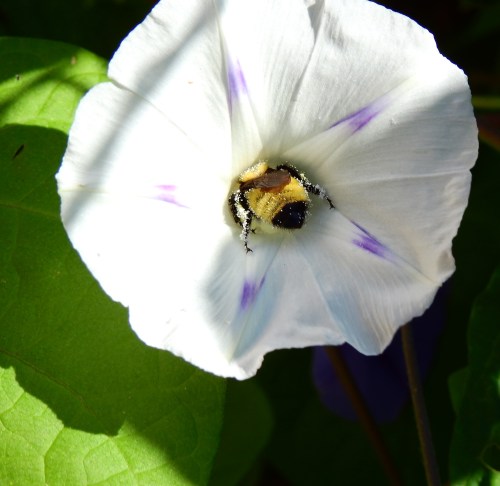
Posts Tagged ‘bees’
pollinator at work
Posted in Inspiration, Nature Notes, tagged beauty, bees, bumblebees, insects, Inspiration, landscape, nature, Photography, pollination, pollinators, sunflowers on September 20, 2018| Leave a Comment »
pollinator at work
Posted in Inspiration, Nature Notes, tagged bees, Inspiration, Mystic River, nature, Photography, pollen, pollination, urban landscape on September 10, 2018| 1 Comment »
yellow and green
Posted in Inspiration, Nature Notes, tagged Arnold Arboretum, bees, insects, landscape, nature, pollination on July 16, 2018| 1 Comment »
pollinators at work
Posted in Inspiration, Nature Notes, On the Road, tagged bees, flowers, insects, Inspiration, nature, Photography, pollination, pollinators, travel on June 10, 2018| 4 Comments »

Sometimes I get so caught up in trying to photograph the flowers, I forget why flowers exist in the first place. Not for my visual pleasure but to attract pollinators. And they were hard at work in the UC Botantical Garden.


bee hard at work
Posted in Inspiration, Nature Notes, tagged beauty, bees, flowers, insects, Inspiration, morning glories, nature, Photography, pollination on September 1, 2017| 1 Comment »

I’m telling you. There’s a lot to be discovered just standing and watching a patch of morning glories. Have a good Friday!

hard at work
Posted in Inspiration, Nature Notes, tagged bees, flowers, Inspiration, nature, nature photography, Photography, pollen, pollinators, urban landscape on June 14, 2016| 2 Comments »
the bee-friendly garden, a review
Posted in Books I Love, Inspiration, Nature Notes, tagged bees, book review, creativity, diy, flowers, gardening, Inspiration, landscapes, nature, Photography, pollinators on February 15, 2016| 2 Comments »
Bees are not the only pollinators in this world but they are a major one. There are many different species of bees. Growing up in Virginia, I’d heard of sweat bees, and knew bumblebees on sight, but it was the honeybee with its soft gold and black coloring that I most thought of when I heard the word bee. I took for granted its production of honey and the wax harvested from colonies for my candles. And I was quick to bat the insect away when I walked through a field of flowers. As for its role as pollinator, I didn’t think too much about that nor did many until reports of colony collapse disorder made national and international news.

photo by cynthia staples
As noted in the introduction of The Bee-Friendly Garden, “over 70 percent of the world’s plants depend on the pollination services of bees, including many nuts, fruits, tomatoes, peppers, or berries.” While the world might survive without bees, it would be a very different place to say the least.

One of the delights of this book is that the authors, a professional garden designer and an ecologist, educate, inspire and encourage. Regarding the U.S., they describe the difference between native bee species and honeybees, and how bees and wasps look similar but behave very differently. Honeybees with their yellow and black banded bodies are probably the most common image of bees, but native bees come in many shapes, sizes and colors, their bodies evolved to collect the pollen from a wide variety of plants, shrubs and trees. Lists are provided by region of bee-friendly garden compositions, and in turns out that many of those same gardens — a mix of annuals, perennials and more — can attract and support other important pollinators like bats, butterflies and hummingbirds.
The book is an incredible resource and reference guide and I would suggest it as a wonderful addition to one’s gardening library. The authors make clear with straightforward content that you don’t need to be a master gardener or landscape designer in order to create beauty around you and do some good in the world as well. As some of you know, I love to give seeds and plants to friends and family who live across the U.S. This year I will certainly be using this book’s regional plants lists to help guide my selection of seeds.

photo by cynthia staples
I received this book from Blogging for Books for this honest review. Detailed book information available via this link: http://www.penguinrandomhouse.com/books/243475/the-bee-friendly-garden-by-kate-frey-and-gretchen-lebuhn/
bizarre beauty
Posted in Inspiration, Kitchen Inspirations, tagged abstract, beauty, bees, curiosity, flowers, insects, Inspiration, Photography, reflections, still life on March 24, 2015| Leave a Comment »

Last summer, a large bee and I had an altercation in the kitchen. In short, it could not manage to exit out the window through which it had entered and so it now rests in a jar, frozen in time, quite beautiful, I think, if a little macabre. Off and on, I have tried photographing the creature but nothing clicked until yesterday when the sun shone “just right.” Flowers both real and artificial reflected on the surface of the jar. The bee’s wings glowed with iridescent light. Factoring in curvature and irregular thickness of the glass … well, it was a sight that made me grab my camera.

The biologist in me is kind of curious what will happen over time, but likely what will is happen is that later this spring I will bury the bee in a pot full of flowers or maybe under that big oak tree. We’ll see …

a bee and branches in the arboretum
Posted in Branches, Inspiration, Nature Notes, On the Road, tagged Arnold Arboretum, bees, Branches, Inspiration, monotype, nature, Photography, urban landscape, walking on May 11, 2014| 2 Comments »
Perilous Beauty
Posted in Guest Contributor, Inspiration, Nature Notes, tagged backyard gardens, bees, flowers, insects, nature, Photography, photos, pictures on August 13, 2011| 2 Comments »

As my cousin stated, it’s “probably not smart to follow bees,” but what beauty she captured by doing so in her back yard. 😉
Pictures by Lorraine









